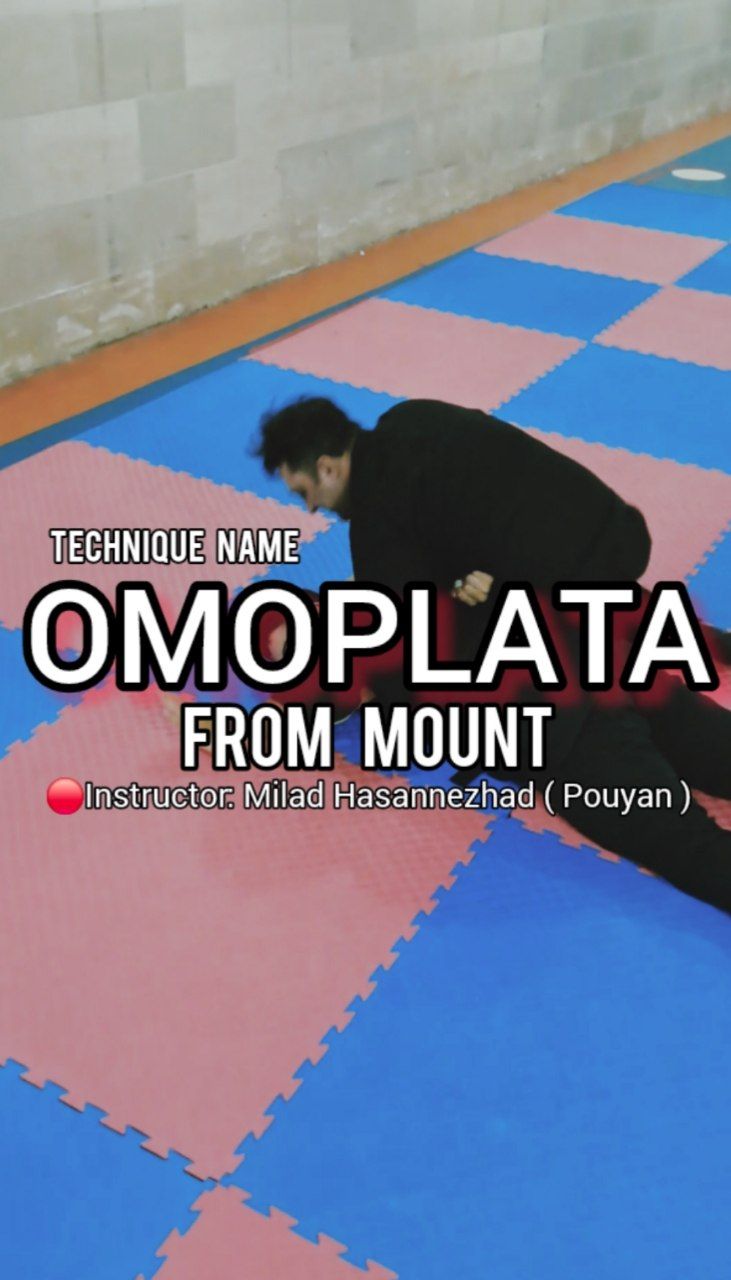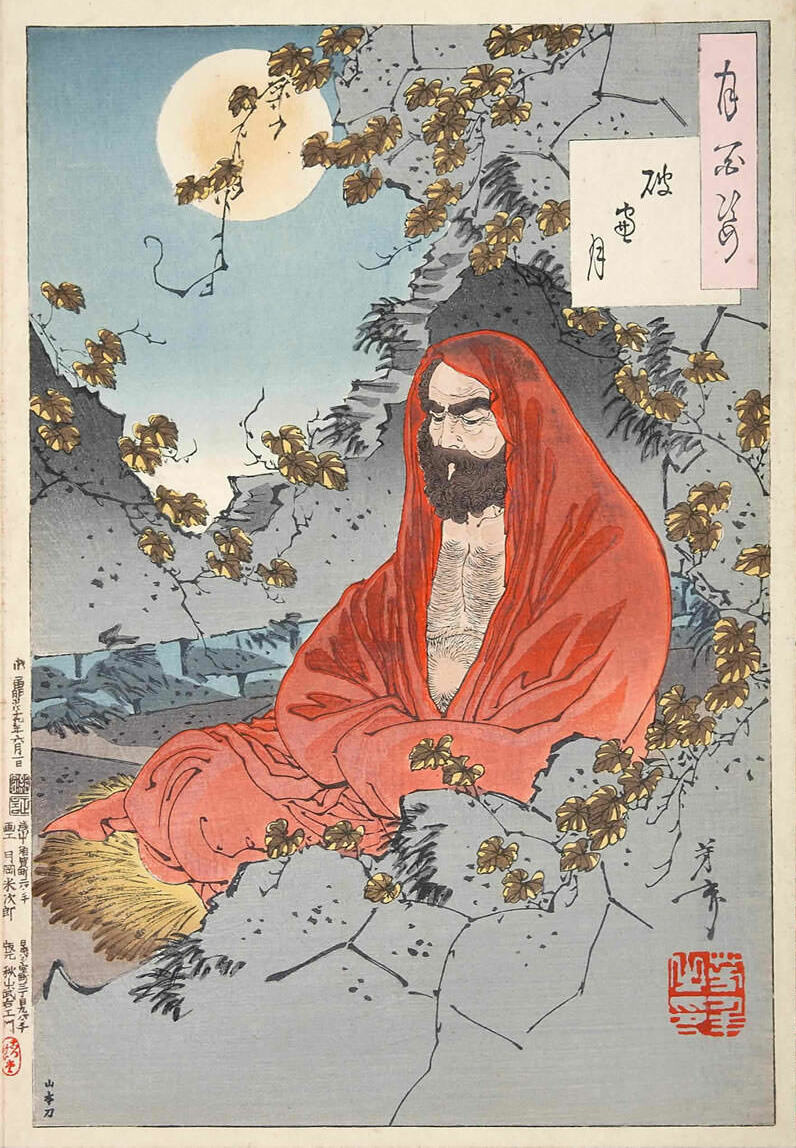Technique name: omoplata from mount🔵
:Instructor
Milad Hasannezhad (Pouyan)
🔴نام تکنیک: قفل کتف با پا از روی سینه / اوموپلاتا از روی مانت
مربی: میلاد حسن نژاد (پویان)

⬇️⬇️⬇️ Click here
tutorial video on YouTube🔵🔵🔵
اینجا کلیک کنید ⬇️⬇️⬇️
جهت دیدن ویدئو آموزش در یوتیوب روی این گزینه کلیک نمایید 🔴🔴🔴
The Omoplata is a fundamental joint lock submission in Brazilian Jiu-Jitsu, designed to apply pressure to the opponent's glenohumeral joint. The name comes from the Portuguese word "Omoplata" meaning "shoulder" or "scapula," which refers directly to the technique's focus on the shoulder and scapula area. The Omoplata is a complex leverage technique that utilizes the anatomical structure of the performer and the target to apply rotational pressure and hyperextension to the shoulder joint
Successful execution of the Omoplata requires a series of precise control and leverage steps, typically starting from the Guard's or Half Guard position. The primary goal is to control the opponent's upper limb (usually one arm) and use the performer's legs as leverage
Mechanism of Execution and Biomechanical Goals
-1
Entry and Initial Control: The performer begins by controlling one of the opponent's arms (usually at the wrist or arm) and placing it between his legs. This step is often accompanied by breaking the opponent's posture and bringing his head closer to the performer's body to prevent initial resistance and escape
-2
Foot Positioning and Leverage: The foot corresponding to the opponent's controlled arm (for example, the performer's left leg if the opponent's left arm is controlled) is passed over the opponent's head and shoulder. The heel of this foot should be placed above the opponent's shoulder to limit his movement and act as a fulcrum
-3
Pivoting and Leverage: The performer then begins a pivoting motion in the opposite direction of the controlled hand (for example, to the right if the opponent's left hand is controlled). Simultaneously with this rotation, the performer's hips are lifted off the ground. This movement causes the lever leg (the leg that is on the opponent's shoulder) to act as a pivot and apply rotational and compressive pressure to the opponent's shoulder joint. This pressure results in a forced external rotation of the opponent's arm and ultimately a hyperextension of the shoulder joint
-4
Final Control and Submission: At this stage, the performer must have complete control of the opponent's body, especially the pelvic area, to prevent him from getting up and escaping. By carefully adjusting the angle of the body and the pressure of the legs, the pressure on the shoulder joint is brought to the point where the opponent is forced to submit (tap out).
Tactical and Strategic Dimensions:
The omoplata is not only an effective submission technique, but is also of great importance due to its tactical flexibility:
-
Transitions: If the opponent manages to defend against the omoplata, the technique often provides opportunities to transition into superior positions such as the Sweep, Back Take, or other submissions such as the Triangle Choke. This feature makes the omoplata a key element in the chain of offensive attacks.
-
Positional Control: Even if the submission fails, the omoplata is a powerful tool for controlling the opponent's posture and movement, allowing the performer to dictate the rhythm of the fight.
-
Reaction and Exploitation: By applying the threat of the omoplata, the opponent is forced to react and defend. These reactions often create spaces for subsequent attacks or a change in tactics
⭐️⭐️⭐️
تکنیک "اوموپلاتا" (Omoplata) یکی از سابمیشنهای مفصلی (Joint Lock Submissions) بنیادین در جوجیتسو برزیلی (Brazilian Jiu-Jitsu) است که با هدف ایجاد فشار بر مفصل گلنوهومرال (Glenohumeral Joint) یا مفصل شانه حریف طراحی شده است. این نامگذاری از واژه پرتغالی "Omoplata" به معنای "کتف" یا "استخوان اسکاپولا" (Scapula) نشأت گرفته است که مستقیماً به نقطه تمرکز این تکنیک بر ناحیه شانه و کتف اشاره دارد. اوموپلاتا یک تکنیک اهرمبندی پیچیده است که با بهرهگیری از ساختار آناتومیکی بدن اجراکننده و هدف، فشار چرخشی و هایپرکود (Hyperextension) را بر مفصل شانه اعمال میکند.
اجرای موفقیتآمیز اوموپلاتا مستلزم یک سری مراحل دقیق کنترلی و اهرمبندی است که عمدتاً از موقعیت گارد ها (Guard's) یا نیمگارد (Half Guard) آغاز میشود. هدف اولیه، کنترل اندام فوقانی حریف (معمولاً یک دست) و استفاده از پاهای اجراکننده به عنوان اهرمهای فشار است.
مکانیسم اجرا و اهداف بیومکانیکی:
1. ورود و کنترل اولیه: اجراکننده با کنترل یک دست حریف (معمولاً از ناحیه مچ یا بازو) و قرار دادن آن بین پاهای خود، شروع میکند. این مرحله اغلب با شکستن پاسچر (Posture Break) حریف و نزدیک کردن سر وی به بدن اجراکننده همراه است تا از مقاومت و فرار اولیه جلوگیری شود.
2. موقعیتگیری پا و اهرمسازی: پای موافق با دست کنترلشده حریف (به عنوان مثال، اگر دست چپ حریف کنترل شده است، پای چپ اجراکننده) از بالای سر و شانه حریف عبور داده میشود. پاشنه این پا باید در بالای کتف حریف قرار گیرد.تا حرکت وی را محدود کرده و به عنوان یک نقطه اتکا عمل کند.
3. چرخش و ایجاد فشار اهرمی: اجراکننده سپس یک چرخش محوری (Pivoting Motion) را به سمت مخالف دست کنترلشده (مثلاً به سمت راست اگر دست چپ حریف کنترل شده) آغاز میکند. همزمان با این چرخش، باسن اجراکننده از سطح زمین بلند میشود. این حرکت باعث میشود که پای اهرمی (پایی که روی شانه حریف است) به عنوان یک محور عمل کرده و فشار چرخشی و فشاری را بر مفصل شانه حریف اعمال کند. این فشار، منجر به چرخش خارجی اجباری بازوی حریف و در نهایت هایپرکود مفصل شانه میشود.
4. کنترل نهایی و اعمال سابمیشن: در این مرحله، اجراکننده باید کنترل کاملی بر بدن حریف، به ویژه ناحیه لگن، داشته باشد تا از بلند شدن و فرار وی جلوگیری کند. با تنظیم دقیق زاویه بدن و فشار پاها، فشار بر مفصل شانه به نقطهای میرسد که حریف مجبور به تسلیم (Tap Out) میشود.
ابعاد تاکتیکی و استراتژیک:
اوموپلاتا نه تنها یک تکنیک سابمیشن مؤثر است، بلکه به دلیل انعطافپذیری تاکتیکی خود، از اهمیت بالایی برخوردار است:
- انتقال به تکنیکهای دیگر (Transitions): در صورتی که حریف موفق به دفاع در برابر اوموپلاتا شود، این تکنیک اغلب فرصتهایی برای انتقال به موقعیتهای برتر مانند سویپ (Sweep - انتقال به موقعیت بالا)، پشتگیری (Back Take)، یا ورود به سابمیشنهای دیگر نظیر مثلث (Triangle Choke) را فراهم میآورد. این ویژگی، اوموپلاتا را به یک عنصر کلیدی در زنجیره حملات تهاجمی تبدیل میکند.
- کنترل موقعیتی (Positional Control): حتی در صورت عدم موفقیت در سابمیشن، اوموپلاتا ابزار قدرتمندی برای کنترل پاسچر و حرکت حریف است که به اجراکننده امکان میدهد ریتم مبارزه را دیکته کند.
- ایجاد واکنش و بهرهبرداری: با اعمال تهدید اوموپلاتا، حریف مجبور به واکنش و دفاع میشود. این واکنشها اغلب فضاهایی را برای حملات بعدی یا تغییر جهت تاکتیکها ایجاد میکنند.

_6gbc.jpeg)
